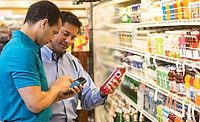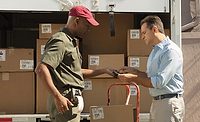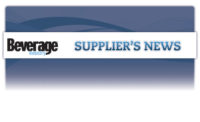Direct-store-delivery solutions help simplify delivery operations
Suppliers develop mobile, user-friendly software, hardware solutions

The retail market continues to be impacted by the embracement of omnichannel shopping. Consumers’ acceptance of purchasing consumer packaged goods (CPGs) from a variety of retail outlets as well as their desire for more choice is not just impacting retailers but the entire distribution network as it looks to accommodate a much more diverse shopping universe.
“We continue to see distributors dealing with more SKUs to manage and more accounts to service,” says Larry Edelson, marketing director for VIP, Colchester, Vt. “Maybe their total SKU count isn’t increasing as much as it did over the last several years, but there’s a lot of churning as new products are introduced and others are discontinued. And there are new accounts popping up all the time, and different types of accounts as online ordering and delivery becomes a viable distribution channel.
“As a result, distributors need to take a different approach, what they’ve been doing for decades just isn’t good enough anymore,” he continues. “Modern successful distributors are embracing these changes and addressing these trends by employing new user-friendly devices, making online ordering available to some retailers, and providing more sophisticated selling tools, data and communication tools to their teams in the trade.”
Paul Rutherford, president of Holland, Mich.-based Rutherford & Associates, details how field agents within the distribution network are turning to direct-store-delivery (DSD) solutions to streamline the process.
“The complexity of selling at retail continues to increase, accelerating a shift in the role and activities of the pre-seller toward becoming a consultant,” Rutherford says. “From identifying the right SKUs for any given retailer (out of an ever expanding portfolio of products), to effectively supporting supplier and retailer initiatives, to investing the right amount of time and support (POS, samples, etc.) into each retailer based on granular segmentation strategies, pre-sellers inform, advise, recommend and update.
“DSD solutions can help in two particular ways,” he continues. “One is the timely, relevant and contextual presentation of key information when it is needed. The other is analytical support to simplify and commoditize the ‘order taking’ part of the role. Some distributors are moving to ‘hypermerchandisers’ that take care of inventory counts and order entry, freeing up the salesperson to focus on high-value activities such as portfolio and margin optimization.”
Derek Curtis, vice president of sales for Minneapolis-based HighJump, calls to attention the urgency that SKU proliferation has placed on DSD solutions.
“SKU proliferation just magnifies the need for enhanced field capabilities,” he says. “The idea of manually managing the vastly increased portfolio size along with their related number of promotions seems inconceivable in today’s market place.
“Even simple tasks, such as tracking inventory from warehouse to truck to shelf is complicated by seasonal or promotional products with similar packaging or identifiers,” Curtis continues. “Add in lot or expiration tracking, and the effort associated with these formerly simple tasks may overwhelm DSD operators dealing with inadequate system capabilities.”
As distribution tasks become more complex, Heather Larabee, executive vice president of marketing of Denver-based GoSpotCheck, highlights how technology is no longer an “if,” but a question of what, when and how, depending on the level of sophistication.
“Computer vision and machine learning are being used to reduce labor and analyze sets,” Larabee says. “Field reps can take photos of trained UPCs and understand within 30 seconds what’s there, what’s not and how sets comply to planogram. They then can use the time saved during this process for higher-value work: writing sales orders, solving problems, and building relationships in-store.
“This technology is also enabling stronger localization of sets which can drive additional top-line growth, profitability and customer loyalty, both in-store and online,” she continues. “Data-driven insights from the field provided in real-time inform marketing decisions, improve new product launches, surface consumer insights, grow eCommerce channels and help brands grow market share.”
For beverage distribution, Paul Hilton, North American field mobility lead for Lincolnshire, Ill.-based Zebra Technologies, points out that much of the market already has embraced DSD solutions and is moving onto the next phase of utilization.
“Unlike most direct-store-delivery (DSD) markets, beverage distribution has put operating system (OS) migration in their rearview mirror and are focused on new ways to optimize their supply chain and increase visibility into their mobile operations, such as consolidating mobile workforces where possible, asset tracking and food safety solutions,” he says. “DSD solutions are aiding these efforts by looking to utilize technologies, like sensors and [radio-frequency identification] (RFID) that are becoming more practical, to capture consumer engagement, track reusable assets and improve overall account service.”
However, sales agents are not the only representatives benefiting from DSD technology. Delivery drivers are utilizing these solutions, which are not only helping them but also the customers they are servicing.
“Ongoing fleet optimization is paramount as is meeting the increasing expectations driven by easy-to-use consumer applications,” says Allison Parker, vice president of marketing at Boston-based Wise Systems. “Specifically, there’s increasing demand for real-time visibility and dynamic routing to mitigate the effects of unanticipated delays that drivers encounter every day. In addition, there’s increased interest in giving customers visibility into upcoming deliveries — just as they would in any popular ride-hailing app, as consumer experiences are now carrying over into business-to-business applications. Lastly, for teams with field merchandisers, there’s a need for technology to coordinate between drivers and merchandisers and eliminate unnecessary downtime.”
Solutions across the board
In today’s distribution environment, employee recruitment and retention is increasingly challenging for operations’ managers. As beverage wholesalers address this factor, companies need technology that employees easily can learn.
“Solution providers are catering to the user’s experience by creating easy-to-use applications accessible on familiar platforms like iOS and Android,” says Jake Sampson, vice president of sales and marketing for Fort Collins, Colo.-based Encompass Technologies. “The ease of usability enables distributors to have a shorter onboarding period while having access to a feature-rich, intuitive experience.
“A great example of this is voice-directed picking,” he continues. “This specific picking process allows the end user to utilize an iOS or Android device that directs them where to go, what to pick, as well as what quantity to pick, allowing the user to be successful without needing tribal knowledge of the warehouse or products.”
Sampson adds that DSD software solutions are helping simplify many processes while hardware solutions are becoming more user-friendly.
“We’ve seen DSD hardware suppliers begin to cater to existing mobile solutions (iPhones, iPads, iPods, Android devices, etc.) because employees are beginning to demand the same type of user experiences at work as they are used to in their personal lives,” he explains. “Deploying intuitive mobile solutions definitely helps increase efficiency, as well as reduce turnover rates and increase employee morale.”
Advancements in DSD solutions also can help field agents more effectively structure their days and ultimately increase sales performance, experts note.
“Confirmation of proof of service is another game-changing benefit of mobile technology,” say David Larson and Jim Chenoweth of ClickSoftware, Burlington, Mass. “Using automatic identification of the length of time an employee actually spends at a retail location versus reported times provides distribution management with a positive confirmation of how much time workers are spending servicing their accounts. Mapping the stop duration against the type of retail outlet; c-store, on-premise retail, big box, etc., enables managers to improve revenue through ensuring that the correct service levels are being provided.”
The two add that many field agents tend to use personal vehicles when visiting accounts, and increasingly are relying on DSD solutions that help them manage expenses and company records.
“With most of the beverage industry population driving their personal vehicles for company business, accurate and timely mileage reimbursement can quickly expand into a labor-intensive task,” they say. “Solutions that provide field employees with the ability to enter mileage information, automatically calculate the reimbursement rate, and validate the reported mileage against tamper-proof GPS records will save distributors money through the elimination of overpayment.”
ClickSoftware’s StreetSmart offers these capabilities as well as the ability to capture on-site data, Larson and Chenoweth state.
VIP’s Edelson also notes how beverage distributors increasingly are in need of advanced, easy-to-use solutions.
“At VIP, we’re looking to help distributors change the game in the trade by equipping them with more sophisticated tools to keep everyone on the same page,” Edelson says. “All of the visit notes, activity and contacts at an account is available to every member of the team that services that account: sales reps, delivery drivers, merchandisers, supervisors — everyone.
“With proper permissions, information can be shared between suppliers and distributors using KARMA,” he continues. “For example, when a supplier gets a commitment from a retailer to carry one of their new products, this information can be shared with the sales rep for that retailer. This information is available to the sales rep when they are working with that account — getting them the right information at the right time. No more relying on sales reps to remember what they saw in an email or a text at a different time, they now see this information when they need it the most.”
GoSpotCheck’s Larabee details how network speed and artificial intelligence (AI) are becoming an important part of DSD’s future advancements.
“The 4G, and now, 5G networks have sped delivery of services and technology to the field,” she says. “Machine learning, computer vision and AI have started to unlock powerful insights in the ‘last 10 feet’ at a store level. Robotics and automation are playing an increasing role in driving cost savings. And the proliferation and affordability of mobile devices over the last 10 years have transformed the DSD landscape.
“With 95 percent of Americans having cell phones today, and 77 percent of them owning smartphones (according to the Pew Institute), companies can deliver and retrieve potent data with the mini computers we carry in our pockets, in just seconds,” Larabee continues. “Software developers, however, need to be mindful of field conditions where network connectivity may remain spotty. This focus on the customer journey is one of the key reasons GoSpotCheck built an app that fully functions in offline mode. There’s nothing more frustrating to a field rep than to lose work or not be able to perform tasks because Wi-Fi is spotty.”
Larabee explains how GoSpotCheck’s commitment to DSD solutions already is helping companies in the beverage market.
“GoSpotCheck reimagines how the mobile workforce works, while paying close attention to customer needs and pain points,” she says. “Our computer vision/machine learning platform, HiFi, is helping companies like PepsiCo today, and we are committed to building out additional functionality beyond cold box to menu, tap and shelf.”
Larabee foresees machine learning will continue to see its roll in DSD operations expand. “We believe we’ll see exponential growth in the market for machine learning and computer vision/image recognition technologies, optimizations in supply chain and manufacturing using these technologies, and things like blockchain coming online, especially to address needs of transparency and traceability in ingredients and manufacturing practices,” she says.
Rutherford & Associates’ Rutherford adds that more distributors are taking advantage of machine learning for DSD operations.
“Leading DSD providers leverage it in the cloud or on mobile platforms (like Apple’s coreML) to provide key insights at the right time and place,” he says. “The eoTouch platform leverages machine learning and natural language processing for many advanced features such as the Rebecca voice assistant, on-board recommender system for product/retailer fit, and trained models to support computer vision use cases, such as extracting code date information from packages.”
Wise Systems’ Parker also touts the benefits of machine learning and how those in beverage distribution are taking advantage of these technologies.
“Mobile and cloud infrastructure, combined with machine learning, are enabling software solutions to scale the roles of planners and dispatchers by using big data and computing power to supplement the team’s capabilities,” she says. “In addition, they are also enabling DSD teams to implement real-time dynamic routing, helping them stay competitive.
“With our autonomous dispatch and routing solution, Wise Systems is enabling our beverage customers, including Anheuser-Busch’s Tier 2 delivery operations, to increase on-time deliveries by up to 80 percent, while decreasing fleet mileage up to 15 percent,” Parker continues.
Retailers also are seeing how DSD solutions can address an industry-wide problem: out of stocks.
“Out of stocks continue to be one of the biggest pain points of any retailer,” Zebra Technologies’ Hilton explains. “Beverage retailers are no different and are looking for ways to eliminate them. DSD solutions with a robust sales forecasting tool can help make sure the right amount of inventory is stocked. While there’s always been a focus on inventory accuracy from retailers, they’re putting even more focus on it now with the rise of online ordering and click-and-collect offerings. We are increasingly seeing retailers looking to distributors to share more data to improve the inventory accuracy in their systems.”
Encompass Technologies also is taking notice of the real-time response that retailers need in today’s online driven world. To help retail customers, the company developed DSDLink, a retailer ordering tool.
“The solution allows retailers to order from all of their distributors at once, at anytime, anywhere,” Sampson says. “This takes a huge burden off of the retailers, and they’re able to save time, as well as reduce any errors they were experiencing with the traditional ordering process.”
Zebra Technologies’ Hilton also notes how DSD solutions are seeing the use of RFID for reusable assets and food safety.
“When combined with a DSD solution, RFID is helping manufacturers and distributors track the location of reusable assets and the product they carry, as well as its condition to minimize loss and increase visibility for food safety purposes,” he says. “Although they’re not new technologies, sensors and passive RFID are becoming more practical and seeing increased adoption and use. DSD solutions can become a valuable component of a comprehensive food safety solution with the ability to verify product condition and identify a late food safety concern before the product is delivered to an account.
“Loss of product and reusable assets also remain problematic, but RFID solutions can easily pay for themselves in a brief timeframe,” Hilton continues. “In addition, with the ever-increasing amount of field data being collected, shared and added to the cloud, this is enabling businesses to more quickly optimize their operations.”
Whether its distributors or retailers, DSD solution providers recognize the importance of staying on top of the latest technology capabilities to streamline operations and protect client data.
“HighJump provides our partners with technology updates three times a year in order to keep them on top of any recent changes in requirements, compliance or industry trends,” Curtis says. “Most recently, our focus has been on driving proactive sales enhancement functionality.
“Understanding that field users have less and less time to spend interacting with their end customers, while dealing with a much larger portfolio, we had to reduce the reliance on ‘tribal knowledge’ sales techniques, and instead prompt for desired behavior or interactions,” he continues. “This trend has followed the movement away from smaller mobile device screens like traditional phones, and takes advantage of the increased real estate of current phone screens that are now encroaching upon screen sizes formerly known as mini-tablets.”
As DSD solutions progress, experts anticipate that digital solutions will play an even large role in the future.
“Some key changes around the corner include greater utilization of artificial intelligence technologies for insight extraction and decision support, new ‘wearables’ platforms for selling, servicing and picking (including the upcoming Apple smart glasses), a different interaction paradigm with augmented reality applications, leveraging computer vision to provide in context information, and the rollout of 5G that will allow DSD solutions to tap into high-bandwidth, low-latency networks to create more powerful applications that shift computation intensive loads to cloud or edge platforms,” Rutherford & Associates’ Rutherford says. BI
Looking for a reprint of this article?
From high-res PDFs to custom plaques, order your copy today!







